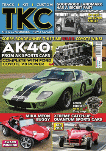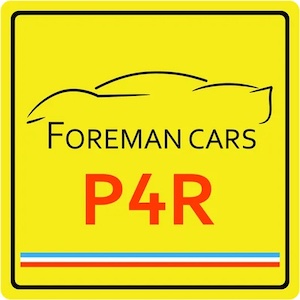LET THE BUS TAKE THE STRAIN – THE CAREER OF ALAN PONSFORD THE DESIGNER OF THE AVA K1
PHOTOS TO FOLLOW
Crikey, if this was Total Bus magazine the name Alan Ponsford would be very familiar to you. Much like the CVs of Lee Noble or Jeremy Phillips may have escaped the attention of a member of the Duple Owner’s Club, Alan is the big cheese of bus and coach design. However, he also designed one of the finest handling kitcars of all time in the guise of the AVA K1. Possibly the most advanced in terms of looks, too. Some 36 years after it was unveiled it still seems box-fresh according to STEVE HOLE …
I was reading something online about a year ago that related to a chap called Alan Ponsford. That name rang a big bell with me. It was a feature on truck racing, of all things. For the rest of the day, I kept having that name rolling around my head. I knew I recognised it, but I just couldn’t think why.
Then it dawned on me. A confirmatory check in the book of words and EUREKA! ‘Alan Ponsford’ was the man who designed the stunning AVA K1, back in the eighties, a car that still stacks up some 36 years after it first turned a wheel in anger.
Further interweb research on Mr Ponsford reveals a subsequent glittering career in automotive design. As well as those aforementioned racing trucks, if you see a bus or coach plodding up the motorway or on the local ring road or High Street there’s a very fair chance it was designed by Alan Ponsford. In case you ever wondered who designed these things, then wonder no more – Alan has been the main man of bus and coach design for many years.
Born in Harrow, north London, an Honours Degree in Mechanical Engineering at Imperial College, London led to a so-called ‘thick sandwich’ course at Leyland. Forget notions of a pop-up street food vendor, this was the first year of a course spent at the iconic – and once giant – manufacturer with a further three years back at Imperial and then the final year at Leyland. Hence ‘sandwich’.
Alan says that back then there was always something going at Leyland (nicknamed ‘Lazy L’) or at the British Leyland empire in general. He remembers with fondness one summer working at Rover Gas Turbines engaged on the gas turbine project for Leyland truck use.
“Longevity was a problem at only 23 hours between failures especially since they were installed in fuel tankers delivering to petrol stations. They were running double shifts, so 23 hours came up in a couple of days. Drivers worked longer hours behind the wheel then.
“Similarly, the then new express coaches running at 70mph could cover up to 250,000 miles per year!” he recalls.
Alan set up his own design company called Capoco in 1977 and he describes himself by various titles including designer, engineering designer and design engineer, although he has always followed the study and development of Total Design: “For me, this has been a fifty-year challenge to understand all the ingredients of a vehicle’s make up.” he tells me.
He learnt structures at British Leyland, steering and suspension at Moulton, and aerodynamics at both BL and Moulton although styling has always played a large part in his work at Capoco.
He also says that a contract from Chinese manufacturer, First Auto Works in year 2000 was a pivotal moment for him. It encompassed all the ingredients right through the definition of the CNC surfacing information, thus his Total Design philosophy!
[crosshead] BUSES AND COACHES
I ask Alan how he got into being a bus and coach design specialist: “It was all down to my priceless training at British Leyland,” he tells me.
“My training included spending two weeks in every department. When I say ‘every’ department, I mean every department. All the practical elements on the production lines, engine assembly, gearbox construction, axle building, chassis build, the foundry, service department, injector shop and electrical,” he continues.
“I do some lectures for Robert Peston’s Speakers for Schools Programme and I tell students that unfortunately, those wonderful opportunities that I had aren’t available to them, at any price, anymore in the UK. We have lost our vertically integrated ability to manufacture vehicles.” Alan says ruefully.
Anyway, back to the buses and his real passion for them came from his two weeks at BL on body development. This is when Leyland was developing the Titan and B15 double-decker buses. “I was hooked,” he laughs.
So much so that he finished his sandwich course early after being head-hunted by Rotork, a company involved in bus and coach design and analysis and high-speed commercial and military boats
His first job working for himself was on the Moulton Coach, a typically quirky Sir Alex Moulton design, with an engine in the front, four axles, with two of them steering and two driving, plus Hydragas suspension on each wheel. “It also had a tubular spaceframe chassis,” Alan remembers.
By the late eighties, his hard-earned reputation meant that he was sought after for his design work. Companies such as Dennis commissioned him first on the Javelin coach, followed by the Dart single-decker bus and then the larger Lance. This in turn led to a low-floor version of those products, the Lance Super Low Floor is the first such vehicle in the UK.
By 1990, another well-known bus manufacturer, Optare was knocking on Alan’s door and he designed their version of the Metrorider for them, the start of a long-term arrangement followed by the Excel, Solo, Tempo, DD2000, Alero and Versa.
Alan says that his favourite bus design is the Dart, the best-selling range of UK buses of all time, which as he says in typically modest fashion ‘is nice’.
The Solo was a greater technical challenge in controlling the weight distribution with the front axle right forward. “It needed to ensure the front and rear suspension maintained stability; think original Porsche 911. The Trident 3 became the Enviro 500, which has sold really well into global markets. It was actually quite moving to visit Hong Kong in 2012.
I went out there first in 1995 when the Trident 3 was being developed for Kowloon Motor Bus and CityBus.
“They were the first low-floor deckers and ordered for the new airport on Lantau Island. The initial order was for 1000 buses. Usually, almost always, orders are split between manufacturers, but not this time. Rival Volvo even offered to let them have some products for free, but no takers. The last I heard, sales were approaching 1bn USD,” he explains proudly.
Away from buses, he’s also very proud of the AVA K1 kitcar (more on that shortly) and Dione, the coal-fired, steam-powered wooden motor launch (I told you he was a versatile designer! – Ed).
Alan classes Mobilicity as his most visionary design, being an electrically driven, autonomous pod, so a 12-seat driverless taxi, in reality. “I commissioned this research project with the famous Vehicle Design Department at the Royal College of Art in London. It was to celebrate Capoco’s 25th anniversary in 2002 and was tasked with creating a public transport system for 2027, notionally Capoo’s fiftieth anniversary. It still looks like a good stab at forecasting the near future as we get closer to that date.
I ask Alan why with his pedigree and track record he hasn’t trumpeted his work to a wider audience. Everybody within the bus and coach sector knows him very well, but outside of that, not so much.
‘That’s quite simple, really. It worked to keep a low profile. If it ain’t broke, don’t fix it, type attitude. So, I stuck to this behind-the-scenes approach. Companies would be happy to declare outside help for, dare I say, the more superficial aspects of styling or graphics, but not keen on revealing that Capoco had design and analysis contracts for every Dennis chassis from around 1986 to 2016, some 20 years of production. The same for Optare and the other manufacturers, as it would undermine their core competencies, so fundamental to company value,” he tells me.
[crosshead] THE AVA K1 – WAY AHEAD OF ITS TIME
I ask Alan how the K1 came about. “It was a combination of factors really. My brother built a full-house Cooper S, which I inherited. It used the full BMC Special Tuning catalogue, which covered both racing and rallying Coopers.
“Then we went to see a chap in Birmingham and bought an engine from, as it turned out, John Rhodes. He had just won the European Touring Car Championship and we had that 1293cc A-Series motor.
“Later on, I bought an all-over pistachio green Elan Sprint FHC. I had chums at Lotus, so I managed to obtain a new galvanised chassis from the factory. It came home atop my Renault 5 GTL – on the roof rack.” Alan laughs.
One day shortly after Alan read a piece in Motor [ITALICS] magazine saying that a well-driven GTi could match anything, in the real world, on real UK roads and conditions. Alan: “At the time front-wheel drive rally cars were actually beating the four-wheel drive cars in tarmac rallies, due to their lighter weight and nimble handling.”
This all got Alan thinking and working around the parameters of a race-spec Cooper S, an Elan Sprint and front-drive competition and road cars and he arrived at the formula for the AVA K1.
Meanwhile, historic racer and skilled engineer Nick Topliss was fitting Alan’s new Lotus chassis he’d bought under his Elan and the rest as they say is history – “Albeit not a very long or successful one,” he laughs. Before long, Alan and Nick had set up AVA Cars in a suburb of Frome. They became lifelong friends having been introduced by mutual acquaintances at Moulton.
I ask Alan how long it took to take the basic concept to the finished car that wowed journalists and the general public at the Kit Car Action Day at Castle Combe in 1986.
“Not long. We looked for a popular, high-volume donor car and Ford was on pole in that regard. Nick and I realised that the XR3, RS1600i and RS Turbo models were the mutt’s nuts, so off we went.” Alan tells me with a glint in his eye.
The AVA K1 should have sold by the thousand. Everybody raved about it. It went well too I seem to recall. I drove two examples back-to-back at Castle Combe (a standard car and also the lightweight RS version, and I marvelled at them. I was knocked out by the way it looked, the way it was handled and the way it went.
At the time, a friend’s dad had an Escort RS1600i, which as Alan says, was well-regarded. That was a good car, I remember, but I definitely think that the AVA K1 was better than it in every way.
So, why didn’t it sell in the numbers expected? “That’s easy, Steve. It was scale or lack of it. There was minimal investment really. I realised I was running two companies badly – Capoco and AVA.
“So, I did a Compare and Contrast exercise. Capoco was all revenue and little risk as my customers were OEMs. On the other hand, AVA was little revenue and much risk as our customers were Joe Public.
“OEMs could not plead ignorance or lack of testing, if a design has faults, whereas Joe Public, quite rightly, could do exactly that. So, unfortunately, we pulled the plug,” he says ruefully. Alan goes on to tell me that AVA K1s only seemed to be bought by racing drivers and car collectors.
Alan: “The wider market, especially back then, was all about replicas. I wanted to do a proper OEM-style original creation. This was the arrogance of youth on the basis that ‘build a better mouse trap and the world will come knocking’. Well, a few did, but not enough to justify its existence.”
I ask about the ‘secrets’ to its unbelievable cornering. “Being front-wheel drive, it is inherently more directionally stable than mid- or rear-engined devices. That said, for ultimate speed, a mid-engine configuration is best. But there are issues going that route, especially from the OEM approach I wanted to take” Alan says ruefully.
“The AVA chassis shared the same Escort location points, pretty much, which were conveniently tabulated in our first drawing. This came from the crash repair and alignment industry. Thanks, guys! We later got amazing help from Rod Mansfield at Ford’s Dunton plant.”
“Rod founded and ran the Special Vehicle Engineering team that created the RS products division. I was a design judge at the NEC Motor Show one year and chatted with Rod. He invited us down to Dunton and was both kind and very generous. Amazingly he arranged for full-sized, (1:1), paper prints to be sent to us from Ford Cologne. This would never, ever happen now!” Alan laughs.
The prints covered the suspensions, plus the whole engine bay. So, this was all the assemblies they were carrying over to the AVA K1 so, drop them off the Escort Mk3 and slip them under their stainless-steel chassis and aero-tested body. Simples!
Therefore, despite the talent pool and the considerable input from Rod Mansfield, the AVA K1 joined the Ones That Got Away list, right up at the very top of it, too. That wasn’t quite the end though. A chap called John Burton briefly resurrected the project although ultimately this didn’t last long.
There’s always been a belief that the K1 project was sold and ended its days in Germany. This is the story that I and many of my kitcar journalist colleagues have always believed. Alan dispels this as a myth, however.
“There is a bit of fact there, to be honest. One day, I was coming down a streaming wet M1, in my K1, returning from a Capoco project meeting. On days like that, I loved the front-drive layout. Just floor it, no twitching, no aquaplaning as the lightly laden rears tracked the strip cleared by the fronts.
“Anyway, a German-registered VW pulled in behind and tailed me for some time. This turned out to be a chap called Josef Adlfinger, who had noted the telephone number on the AVA’s rump. We held a number of meetings and negotiations but could not agree on a price. We were just too far apart,” Alan tells me.
So, there you have it. A brief round-up of the career achievements of a hugely talented designer who made his name in the bus and coach industry but is sadly all but unknown in ours these days. Hopefully, this feature will address that slightly. I have wondered several times what other kitcars Alan would have produced during the intervening years. Follow-ups to the K1, which is now an amazing 37 years old.
Look at the car in the photos in this feature. To my eyes, the K1 still looks box-fresh. Alan has recently taken a step back from design and is gently enjoying his semi-retirement he has even retired his memberships with the Chartered Engineers, Institution of Mechanical Engineers, the Royal Society of Arts and the Royal Institution of Naval Architects. Quite a list …
Oh … and as a footnote, Alan told me: “The one that got away was the next in the model line, the K2. Same stainless chassis, but raised clearances etc, named after the mountain …. oh well.”
[Boxout] DID I MENTION TRUCK RACING?
Back in the eighties and nineties I was very keen on truck racing and used to go to most of the British rounds and even did a couple of overseas ones, too at Le Mans on the Bugatti circuit and Zolder.
The European appetite for truck racing has always been greater than in the UK but that’s not to say that UK rounds don’t attract sizeable crowds. It’s just that in Europe they seem to spend more money on truck racing. That and the fact that in the European series were drivers who had backgrounds in single-seaters and/or top-level touring cars.
Having said all that the UK series was very entertaining although in the main the kind of trucks that were racing quite closely resembled those that usually tramping up and down the motorways in the UK or delivering to your local Co-Op.
When the European Super Truck series was introduced there seemed to be no limit to budgets and major truck manufacturers such as MAN and Mercedes-Benz would create lightweight silhouette versions of their truck range. Although they look similar, they were scaled down in size and there was no way they would ever be seen towing a trailer, working for a living.
Us Brits have always been competitive though. In the mid-‘80s drivers of the calibre of Richard Walker and ex-MotoGP rider and commentator Steve Parrish were dominant.
There is one round that sticks in my mind, however, and that was at Donington Park in 1998. The main event was the British Super Truck Grand Prix with support races from the British championship. For fans of the underdog, like me, it was great because the top ten finishers in the latter race gained a wild card entry into the main Super Truck event.
Seeing venerable Volvo F10s and Leyland Roadtrains up against all-singing-all-dancing purpose-built SiSus, MANs and Caterpillars (badged as Zils) was quite stark and the speed differential between them was considerable. I reckon it would be lining up on the grid in a Formula Ford FF1600 with a grid of F1 cars! Having said that, the works drivers would have to work to get past the boys at the back of the grid when it came to lapping them. Not on power, but even on a race circuit, it can be tricky to pass in a truck.
Plus, at every race there always seemed to be a British series runner punching above his weight in the top dozen with the better-funded and faster Super Truck boys. The partisan crowd would always get behind them. The name Stuart Oliver springs to mind there, but there were others.
Anyway, back to Donington and as an added bonus in the British Truck Race final, leading Super Truck entrant Harri Luostarinen in the SiSu was allowed to start at the back of the 24-truck grid as a bit of added entertainment and to highlight just how quick the Super Truck class was by comparison.
The circuit commentator was very excited and built the atmosphere and probably exaggerated the undoubted speed differential. There was a real buzz around Donington when the lights went green though. A damp squib though because a backmarker managed to bury himself into the Armco at the bottom of the Craners. This stopped proceedings for about 45 minutes while they tried to get the truck moved.
Finally, we were off again and more potential carnage as 24 trucks funnelled into Redgate. By the time Harri got out of the pit lane, the leaders were already through and out of the Craner Curves! However, what happened over the next ten laps was quite a sight to behold as he literally carved his way through the British series runners.
Other top-notch drivers in the Super Truck series included Fritz Kreuzpointner a skilful lad in karts and single-seaters and a contemporary (and good friend) of Michael Schumacher. There was also Antonio Albacete a multiple championship winner in the nineties. His brother Alexander raced in F1 for a time. I’ve never forgotten Harri and his SiSu. Little Leyland Roadtrains or Fodens had no answer to the sheer power of that Sisu as it swept past them. So much so that I think Harri won by a mile despite his pit lane start. He may have even lapped up to fifth place.
Why talk of truck racing in this feature? Well, Alan Ponsford was heavily involved in that scene, too. He started off by designing the Zil works trucks for Caterpillar and introduced the concept of multi-link suspension, both front and rear, back in 1993.
The iconic Super Trucks started in 1994 and Alan’s multi-link layout was ‘adopted’ by the whole grid, including all the factory works trucks from Mercedes and MAN! So not just the silhouette cabs but elements of the chassis and trick multi-link suspension systems, as well.
Alan laughs as he tells me: “I was bumped off the project as the Sisu’s designer was Harri’s dad … Oh, well, still my design concepts.”
| Print article | This entry was posted by admin on December 8, 2022 at 4:45 pm, and is filed under Uncategorized. Follow any responses to this post through RSS 2.0. Both comments and pings are currently closed. |
Comments are closed.















